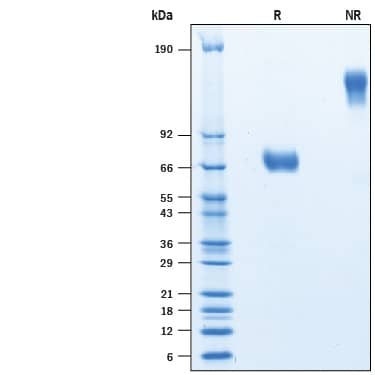Recombinant Human TSLPR Fc Chimera Avi-tag Protein, CF
R&D Systems, part of Bio-Techne | Catalog # AVI981
Biotinylated

Key Product Details
Learn more about Avi-tag Biotinylated Proteins
Source
CHO
Accession #
Structure / Form
Biotinylated via Avi-tag
Conjugate
Biotin
Applications
Bioactivity
Product Specifications
Source
Chinese Hamster Ovary cell line, CHO-derived human TSLPR protein
| Human TSLPR (Gly25 & Val30-Lys231) Accession # Q9HC73.1 |
DIEGRMD | Human IgG1
(Pro100-Lys330) |
Avi-tag |
| N-terminus | C-terminus | ||
Purity
>95%, by SDS-PAGE visualized with Silver Staining and quantitative densitometry by Coomassie® Blue Staining.
Endotoxin Level
<0.10 EU per 1 μg of the protein by the LAL method.
N-terminal Sequence Analysis
Gly25 and Val30
Predicted Molecular Mass
52 kDa
SDS-PAGE
65-80 kDa, under reducing conditions
Activity
The biotin to protein ratio is greater than 0.7 as determined by the HABA assay.
Measured by its binding ability in a functional ELISA.
When Recombinant Human TSLP (Catalog # 1398-TS) is immobilized at 0.5 μg/mL (100 μL/well), the concentration of Biotinylated Recombinant Human TSLP Fc Chimera Avi-tag (Catalog # AVI981) that produces 50% of the optimal binding response is 0.75-7.5 ng/mL.
Measured by its binding ability in a functional ELISA.
When Recombinant Human TSLP (Catalog # 1398-TS) is immobilized at 0.5 μg/mL (100 μL/well), the concentration of Biotinylated Recombinant Human TSLP Fc Chimera Avi-tag (Catalog # AVI981) that produces 50% of the optimal binding response is 0.75-7.5 ng/mL.
Scientific Data Images for Recombinant Human TSLPR Fc Chimera Avi-tag Protein, CF
Recombinant Human TSLPR Fc Chimera Avi-tag Protein Binding Activity
When Human TSLP Protein (Catalog # 1398-TS) is immobilized at 0.5 µg/mL (100 µL/well), it binds to Biotinylated Recombinant Human TSLPR Fc Chimera Avi-tag (Catalog # AVI981) with an ED50 of 0.75-7.5 ng/mL.Recombinant Human TSLPR Fc Chimera Avi-tag Protein SDS-PAGE
2 μg/lane of Biotinylated Recombinant Human TSLPR Fc Chimera Avi-tag (Catalog # AVI981) was resolved with SDS-PAGE under reducing (R) and non-reducing (NR) conditions and visualized by Coomassie® Blue staining, showing bands at 65-80 kDa and 130-160 kDa, respectively.Formulation, Preparation and Storage
AVI981
| Formulation | Lyophilized from a 0.2 μm filtered solution in PBS with Trehalose. |
| Reconstitution | Reconstitute at 500 μg/mL in PBS. |
| Shipping | The product is shipped at ambient temperature. Upon receipt, store it immediately at the temperature recommended below. |
| Stability & Storage | Use a manual defrost freezer and avoid repeated freeze-thaw cycles.
|
Background: TSLPR
References
- Park LS et al. (2000) J. Exp. Med. 192:659.
- Blagoev, B. et al. (2002) Gene. 284:161.
- Ziegler, S.F. et al. (2013) Advances in Pharmacology. 66:129.
- He, R. et al. (2010) Ann N Y Acad Sci. 1183:13.
- Hiroyama, T. et al. (2000) Biochem. Biophys. Res. Commun. 272:224.
- Headley, M.B. et al. (2009) J Imunol. 182:1641.
- Soumelis, V. et al. (2002) Nat Immunol. 3:673.
Long Name
Thymic Stromal Lymphopoietin Receptor
Alternate Names
CRL2, CRLF2, CRLM-2, PCOR1, TSLP R
Gene Symbol
CRLF2
UniProt
Additional TSLPR Products
Product Documents for Recombinant Human TSLPR Fc Chimera Avi-tag Protein, CF
Product Specific Notices for Recombinant Human TSLPR Fc Chimera Avi-tag Protein, CF
For research use only
